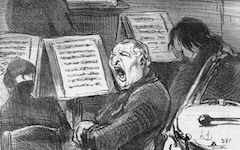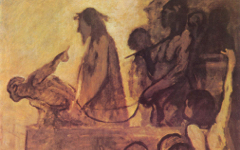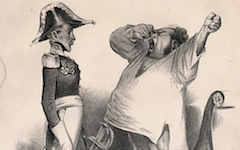Daumier’s Don Quixote and the Dead Mule (1868)

Daumier, Don Quixote and the Dead Mule (1868) Oil on canvas. Musée d'Orsay, Paris.
Click image to enlarge.
Honoré Daumier, a prolific printmaker, painted a series of canvasses based on Cervantes' novel, Don Quixote. In this example the Don and his sidekick, Sancho Panza, ride through an arid valley towards a dead mule. Given Daumier's fascination with the dreaming knight many experts have long argued that he identified with him but without any visual evidence in support.
Click next thumbnail to continue
When, however, Daumier later painted an artist at an easel, he positioned the palette and paintbrush at a similar angle to Don Quixote's lance and shield.
Click next thumbnail to continue

Daumier, Don Quixote and the Dead Mule (detail)
Inset: Daumier, A Painter at His Easel (detail)
Click image to enlarge.
The similar pose thus confirms what specialists have long suspected but never seen: Daumier imagined himself as Don Quixote, the dreaming poet. The Don in Daumier's painting rides through the valley like an artist. Cervantes himself must have identified with his main character, a romantic dreamer, too.
Even Daumier's generic painter conveys through his pose an identity with the poetic Don, standing before his easel like a romantic knight ready for creative struggle.
It is important to remember that forms retain some of their initial meaning even when their appearance changes. That's why it is a good idea to pay attention to forms; you never know when you will see them again.
More Works by Daumier
How Daumier turned a kettle-drum into symbols...

Daumier’s The Orchestra.. ..During A Tragedy (1852)
Notes:
Original Publication Date on EPPH: 29 Jan 2011. | Updated: 0. © Simon Abrahams. Articles on this site are the copyright of Simon Abrahams. To use copyrighted material in print or other media for purposes beyond 'fair use', you must obtain permission from the copyright owner. Websites may link to this page without permission (please do) but may not reproduce the material on their own site without crediting Simon Abrahams and EPPH.



